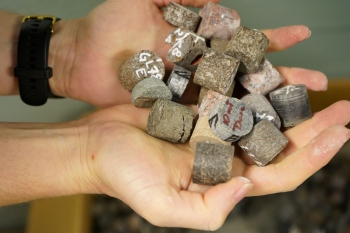About the project
In the middle Paleozoic ('ancient life'; ~440-340 million years ago), life on land emerged, and the first plants and forests developed. Paleogeographical reconstructions of where the continents were located are based on records of Earth’s magnetic field in rocks (paleomagnetism). However, the middle Paleozoic forms a conspicuous gap in our knowledge of Earth’s magnetic field.
The exact limits of the gap have not been established yet, but there is a striking scarcity of high-quality, unambiguous paleomagnetic data for around 100 million years. The absence of high quality paleomagnetic data in this time prevents the understanding of the behavior of Earth’s magnetic field in this key interval for Earth evolution, and hampers the use of paleomagnetism as a tool for dating and correlation. A recurring observation in middle Paleozoic paleomagnetism is that magnetisations are often below sensitivity limits of traditional magnetometers, making them effectively unmeasurable with standard techniques.
Objectives
The PANDA project will investigate promising sedimentary and igneous rocks from the late Silurian to early Carboniferous with new high precision techniques and instruments, in order to characterise the behaviour and strength of Earth's magnetic field in this time period. Advances in magnetometer technology have increased the sensitivity of equipment, which now allows measurements of samples that were previously unmeasurable.

Particularly the newly developed Quantum Diamond Microscope (QDM) will be used to map magnetisations of minerals inside rocks in unprecedented detail.
The PANDA-project will elucidate the behaviour of Earth’s magnetic field in the middle Paleozoic, show whether the behavior of the magnetic field was anomalous, and if so, for how long this lasted.
Financing
The full name of the project is 'A 100 Myr paleomagnetic data gap: Investigating anomalous behaviour of Earth’s magnetic field in the middle Paleozoic'. The project is financed as a FRINATEK – Researcher Project for Young Talents by the Research Council of Norway/NFR, with project number 334622. The project was awarded to Annique van der Boon, PHAB/GEO, UiO.
The project period for the PANDA-project is from 2023 to 2026.
Cooperation
- Department of Geosciences, University of Oslo
- Centre for Planetary Habitability, University of Oslo
- Geomagnetism Laboratory, University of Liverpool
- Paleomagnetic Laboratory Fort Hoofddijk, Utrecht University
Tools / infrastructure
This project benefits from and uses the infrastructure 'The Ivar Giæver Geomagnetic Laboratory (IGGL)'. This laboratory was opened in 2016 and has served as a national Norwegian infrastructure for research on paleomagnetism over several years. The infrastructure with instrumentation are in use by several research projects at University of Oslo.
Visit the Ivar Giæver Geomagnetic Laboratory
![]() The IGGL laboratory was established in connection to The Centre for Earth Evolution and Dynamics (2013-2023) a Center of Excellence av University of Oslo hosted by Department of Geosciences.
The IGGL laboratory was established in connection to The Centre for Earth Evolution and Dynamics (2013-2023) a Center of Excellence av University of Oslo hosted by Department of Geosciences.

